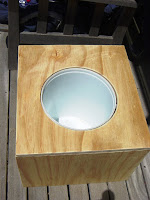It is only 117 pages long.
And I might add, that includes some reference material and contents pages.
The reason I have spent so much time and effort on designing, what I hope will be an odourless and insect-less (read flies) double seater, is that I like spending time on the loo.
I really like it.
Give me a good book and a quiet loo and I am a happy man.
The loo is the only place in our house that I can get any peace and quiet. Really.
And even then, only if you plan it carefully.
Too early in the evening and 33.5 seconds after my bum has hit the seat I get a reasonably chilly "please can you do that later, you have been at work all day and this is the one time you can help out and spend some time with the kids".
Then, if I don't lock the door, by page two of my reading material I normally have a 4 year old elbow resting on my naked knee, supporting a very vocal face, asking question after question. I mean, doesn't the smell mean anything to them. Perhaps they are genetically protected.
And then if I do lock the door, three times out of four, I have very small hands pounding on the outside calling me out. (I suspect to their mothers glee)
"Don't blame me that I have to go to the loo once each morning and once each evening. It is a sign of good health."
Anyway, I very rarely get a chance to have a good read.
So for me, a loo is a sacred place. An escape. The good Lord knows I need one.
Importantly, living in Nqileni means that if I build well I can sit on the loo and watch dolphins.
I am not joking, nor am I exaggerating. This is true.
So yes, a lot of effort has gone into having a good loo.
We will have a double-seater. One for wet and one for solids.
(Dry solids won't smell. You want to separate the two in a way that is practical)
Our wet loo is a very simple bucket system that either get emptied each day, or if the landscape allows I will drain with a 20mm irrigation pipe.
The solid loo is slightly more complex and includes an extraction pipe, a clever way to make sure you don't get flies, and is completely biodegradable. Anyway, I will post the technical specs of this is later (with drawings of course)
Our wet loo is a very simple bucket system that either get emptied each day, or if the landscape allows I will drain with a 20mm irrigation pipe.
The solid loo is slightly more complex and includes an extraction pipe, a clever way to make sure you don't get flies, and is completely biodegradable. Anyway, I will post the technical specs of this is later (with drawings of course)
back to today, today we had a dry run on our wet loo (the bucket one remember)
Basically, you build a box without a bottom (I used 18mm shutter ply)
Our box dimensions are 350mm x 500mm x 536mm. This perfectly fits a 20 litre plastic bucket inside.


The lid of the box is hinged so that it can be lifted up. You then cut a hole in the lid of the box to match and line up with the bucket below, pop on a comfortable loo seat, give everything a good sanding, and Bob's your uncle.
Good result. All it needs is a touch more sanding and a couple of coats of varnish.
The smiling, helpful chap below is our wonderful neighbour, Bruce, who kindly helped me rout out perfect circles in our lids.
He also very kindly lent us two manual drills. Those old ones you turn by hand. Lifesavers in an area without electricity.
Sonja gave us a dry run and a comfort level test (after a glass of wine.)
Followed by Mila, who, bless her soul, gave me a wet run. (Poop in there my girl and you can kiss (your arse as well as) your pocket money goodbye!)
So, we have had our first deposit - so to speak.
Our lovable loo has been christened.








WHERE DO YOU LIVE ? DO you use the remains for you yard ? Can you use it on vegetable gardens?
ReplyDeleteThe contents must be properly composted before applying to a vegetable garden, otherwise the plants could contain e coli. See "Loveable Loo" website for details.
ReplyDelete